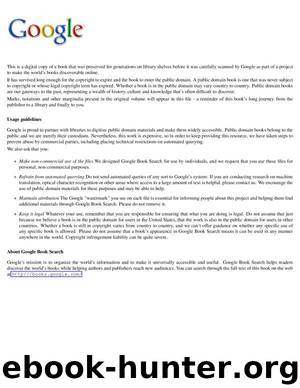Introduction to the Mechanical Principles of Carpentry by Benjamin Hale

Author:Benjamin Hale
Language: eng
Format: epub
Publisher: Richardson & Lord
Published: 1827-03-25T05:00:00+00:00
to ascertain, by means of the principles investigated in the preceding sections, how much force it exerts in producing a directly transverse strain.
If we set off d c to represent the weight W, and from c draw c e perpendicular to A B, we form a triangle dee. And two forces acting upon the point d in the direction of d e and c e, and proportional to these two sides, will (156) exactly balance, or be equivalent to the weight W. But of these two forces, d e acts in the direction of the beam, and therefore can have no effect in producing a transverse strain. The force c e, acting perpendicularly, exerts its whole power in producing this strain, and therefore is the measure of the transverse strain produced by W.
Examples. "
i. Let the angle A B C be 35 degrees, and the weight 1000 lbs.; required the transverse strain. 820.
ii. Let the angle A BC be 25 degrees, and the weight 1000 lbs.
iii. Let the angle A B C be 65 degrees, and the weight 1000 lbs.
A comparison of these examples will show how much the load may be increased upon a beam, if we increase its inclination to the horizon.
iv. Suppose the angle of elevation, A B C, 40 degrees, the length of the beam 20 feet, and 4 inches square; the beam being of ash, and the weight 600 lbs. applied at the centre; what will be the deflection ?
Note. First calculate the force, which acts transversely, as in the preceding examples, and then the deflection as in Part 1, p. 40.
v. What weight would be required to break the above beam ?
Note. First calculate the weight, which would be required to break it when horizontal; then draw e c perpendicular to A B to represent this weight, then from c draw c d vertically till it meets the beam ; c d will be the answer.
vi. Repeat the two preceding questions, supposing the beam to be oak.
vii. Repeat them, supposing the beam to be pine, and 5 inches square.
An inclined rafter is strained not only transversely, but is compressed in the direction of its length. The necessity of consider-
mm
HJ»#Wl. i
ti i > rjB»w .a w^izsr&a gsasE;
: 5Sfe
STATICS.
93
tog this, in finding its scantling, will be apparent from what has been said, Art. 115.
162. The question of transverse strain is solved in the same manner, if we suppose the weight W to rest upon the beam, as in the annexed cut, instead of being suspended as in the last.
Fig. 6.
Download
This site does not store any files on its server. We only index and link to content provided by other sites. Please contact the content providers to delete copyright contents if any and email us, we'll remove relevant links or contents immediately.
| Africa | Americas |
| Arctic & Antarctica | Asia |
| Australia & Oceania | Europe |
| Middle East | Russia |
| United States | World |
| Ancient Civilizations | Military |
| Historical Study & Educational Resources |
Cecilia; Or, Memoirs of an Heiress — Volume 1 by Fanny Burney(32395)
Cecilia; Or, Memoirs of an Heiress — Volume 3 by Fanny Burney(31771)
Cecilia; Or, Memoirs of an Heiress — Volume 2 by Fanny Burney(31740)
The Secret History by Donna Tartt(18785)
Sapiens: A Brief History of Humankind by Yuval Noah Harari(14180)
Leonardo da Vinci by Walter Isaacson(13124)
The Radium Girls by Kate Moore(11885)
Sapiens by Yuval Noah Harari(5272)
How Democracies Die by Steven Levitsky & Daniel Ziblatt(5104)
The Wind in My Hair by Masih Alinejad(5018)
Homo Deus: A Brief History of Tomorrow by Yuval Noah Harari(4784)
Endurance: Shackleton's Incredible Voyage by Alfred Lansing(4645)
The Silk Roads by Peter Frankopan(4423)
Man's Search for Meaning by Viktor Frankl(4370)
Millionaire: The Philanderer, Gambler, and Duelist Who Invented Modern Finance by Janet Gleeson(4320)
The Rape of Nanking by Iris Chang(4115)
Joan of Arc by Mary Gordon(3994)
The Motorcycle Diaries by Ernesto Che Guevara(3953)
Hitler in Los Angeles by Steven J. Ross(3878)
